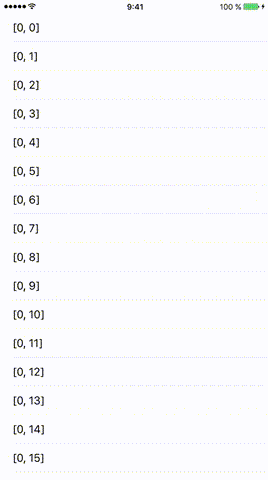问
6 个回答
-
您可以通过添加检查
cellForRowAtIndexPath:方法中的位置来实现.这种方法易于理解和实现:- (UITableViewCell *)tableView:(UITableView *)tableView cellForRowAtIndexPath:(NSIndexPath *)indexPath { // Classic start method static NSString *cellIdentifier = @"MyCell"; MyCell *cell = [tableView dequeueReusableCellWithIdentifier:cellIdentifier]; if (!cell) { cell = [[MyCell alloc] initWithStyle:UITableViewCellStyleDefault reuseIdentifier:MainMenuCellIdentifier]; } MyData *data = [self.dataArray objectAtIndex:indexPath.row]; // Do your cell customisation // cell.titleLabel.text = data.title; BOOL lastItemReached = [data isEqual:[[self.dataArray] lastObject]]; if (!lastItemReached && indexPath.row == [self.dataArray count] - 1) { [self launchReload]; } }编辑:添加了对最后一项的检查以防止递归调用.您必须实现定义是否已到达最后一个项目的方法.
EDIT2:解释了lastItemReached
2023-02-14 05:14 回答 vivianchen1988
vivianchen1988 -
迅速
方法1:滚动到底部
这是Swro版本的PedroRomão的答案.当用户停止滚动时,它会检查它是否已到达底部.
func scrollViewDidEndDragging(scrollView: UIScrollView, willDecelerate decelerate: Bool) { // UITableView only moves in one direction, y axis let currentOffset = scrollView.contentOffset.y let maximumOffset = scrollView.contentSize.height - scrollView.frame.size.height // Change 10.0 to adjust the distance from bottom if maximumOffset - currentOffset <= 10.0 { self.loadMore() } }方法2:到达最后一行
这是swinguX的答案的Swift版本.它检查用户是否已到达最后一行.
func tableView(tableView: UITableView, cellForRowAtIndexPath indexPath: NSIndexPath) -> UITableViewCell { // set up cell // ... // Check if the last row number is the same as the last current data element if indexPath.row == self.dataArray.count - 1 { self.loadMore() } }loadMore()方法示例我设置了这三个类变量来获取批量数据.
// number of items to be fetched each time (i.e., database LIMIT) let itemsPerBatch = 50 // Where to start fetching items (database OFFSET) var offset = 0 // a flag for when all database items have already been loaded var reachedEndOfItems = false
这是将更多项目从数据库加载到表视图中的功能.
func loadMore() { // don't bother doing another db query if already have everything guard !self.reachedEndOfItems else { return } // query the db on a background thread DispatchQueue.global(qos: .background).async { // determine the range of data items to fetch var thisBatchOfItems: [MyObjects]? let start = self.offset let end = self.offset + self.itemsPerBatch // query the database do { // SQLite.swift wrapper thisBatchOfItems = try MyDataHelper.findRange(start..<end) } catch _ { print("query failed") } // update UITableView with new batch of items on main thread after query finishes DispatchQueue.main.async { if let newItems = thisBatchOfItems { // append the new items to the data source for the table view self.myObjectArray.appendContentsOf(newItems) // reload the table view self.tableView.reloadData() // check if this was the last of the data if newItems.count < self.itemsPerBatch { self.reachedEndOfItems = true print("reached end of data. Batch count: \(newItems.count)") } // reset the offset for the next data query self.offset += self.itemsPerBatch } } } }2023-02-14 05:14 回答 Ai剧_本
Ai剧_本 -
最好使用
willDisplayCell方法来检查是否将加载哪个单元格.一旦我们得到indexPath.row最后的电流,我们可以加载更多的单元格.这将在向下滚动时加载更多单元格.- (void)tableView:(UITableView *)tableView willDisplayCell:(UITableViewCell *)cell forRowAtIndexPath:(NSIndexPath *)indexPath { // check if indexPath.row is last row // Perform operation to load new Cell's. }2023-02-14 05:19 回答 手机用户2502862191
手机用户2502862191 -
- (void)tableView:(UITableView *)tableView willDisplayCell:(UITableViewCell *)cell forRowAtIndexPath:(NSIndexPath *)indexPath { NSInteger lastSectionIndex = [tableView numberOfSections] - 1; NSInteger lastRowIndex = [tableView numberOfRowsInSection:lastSectionIndex] - 1; if ((indexPath.section == lastSectionIndex) && (indexPath.row == lastRowIndex)) { // This is the last cell [self loadMore]; } }如果您使用的是Core Data
NSFetchedResultsController,则loadMore可能如下所示:// Load more - (void)loadMore { [self.fetchedResultsController.fetchRequest setFetchLimit:newFetchLimit]; [NSFetchedResultsController deleteCacheWithName:@"cache name"]; NSError *error; if (![self.fetchedResultsController performFetch:&error]) { // Update to handle the error appropriately. NSLog(@"Unresolved error %@, %@", error, [error userInfo]); } [self.tableView reloadData]; }2023-02-14 05:21 回答 黑天鹅猪猪_251
黑天鹅猪猪_251 -
细节
Xcode 10,Swift 4.2
解
使用UIScrollView/UICollectionView/UITableView
import UIKit protocol LoadMoreControlDelegate: class { func loadMoreControl(didStartAnimating loadMoreControl: LoadMoreControl) func loadMoreControl(didStopAnimating loadMoreControl: LoadMoreControl) } class LoadMoreControl { private let spacingFromLastCell: CGFloat private let indicatorHeight: CGFloat private weak var activityIndicatorView: UIActivityIndicatorView? private weak var scrollView: UIScrollView? weak var delegate: LoadMoreControlDelegate? private var defaultY: CGFloat { guard let height = scrollView?.contentSize.height else { return 0.0 } return height + spacingFromLastCell } init (scrollView: UIScrollView, spacingFromLastCell: CGFloat, indicatorHeight: CGFloat) { self.scrollView = scrollView self.spacingFromLastCell = spacingFromLastCell self.indicatorHeight = indicatorHeight let size:CGFloat = 40 let frame = CGRect(x: (scrollView.frame.width-size)/2, y: scrollView.contentSize.height + spacingFromLastCell, width: size, height: size) let activityIndicatorView = UIActivityIndicatorView(frame: frame) activityIndicatorView.color = .black activityIndicatorView.hidesWhenStopped = true activityIndicatorView.autoresizingMask = [.flexibleLeftMargin, .flexibleRightMargin] scrollView.addSubview(activityIndicatorView) activityIndicatorView.isHidden = isHidden self.activityIndicatorView = activityIndicatorView } private var isHidden: Bool { guard let scrollView = scrollView else { return true } return scrollView.contentSize.height < scrollView.frame.size.height } func didScroll() { guard let scrollView = scrollView, let activityIndicatorView = activityIndicatorView else { return } let offsetY = scrollView.contentOffset.y activityIndicatorView.isHidden = isHidden if !activityIndicatorView.isHidden && offsetY >= 0 { let contentDelta = scrollView.contentSize.height - scrollView.frame.size.height let offsetDelta = offsetY - contentDelta let newY = defaultY-offsetDelta if newY < scrollView.frame.height { activityIndicatorView.frame.origin.y = newY } else { if activityIndicatorView.frame.origin.y != defaultY { activityIndicatorView.frame.origin.y = defaultY } } if !activityIndicatorView.isAnimating { if offsetY > contentDelta && offsetDelta >= indicatorHeight && !activityIndicatorView.isAnimating { activityIndicatorView.startAnimating() delegate?.loadMoreControl(didStartAnimating: self) } } if scrollView.isDecelerating { if activityIndicatorView.isAnimating && scrollView.contentInset.bottom == 0 { UIView.animate(withDuration: 0.3) { [weak self, weak scrollView] in if let bottom = self?.indicatorHeight { scrollView?.contentInset = UIEdgeInsets(top: 0, left: 0, bottom: bottom, right: 0) } } } } } } func stop() { guard let scrollView = scrollView else { return } let contentDelta = scrollView.contentSize.height - scrollView.frame.size.height let offsetDelta = scrollView.contentOffset.y - contentDelta if offsetDelta >= 0 { UIView.animate(withDuration: 0.3, animations: { [weak scrollView] in scrollView?.contentInset = .zero }) { [weak self] result in if result { self?.endAnimating() } } } else { scrollView.contentInset = .zero endAnimating() } } private func endAnimating() { activityIndicatorView?.stopAnimating() delegate?.loadMoreControl(didStopAnimating: self) } }用法
loadMoreControl = LoadMoreControl(scrollView: tableView, spacingFromLastCell: 10, indicatorHeight: 60) loadMoreControl.delegate = self
完整样本
extension ViewController: LoadMoreControlDelegate { func loadMoreControl(didStartAnimating loadMoreControl: LoadMoreControl) { print("didStartAnimating") } func loadMoreControl(didStopAnimating loadMoreControl: LoadMoreControl) { print("didStopAnimating") } } extension ViewController: UITableViewDelegate { func scrollViewDidScroll(_ scrollView: UIScrollView) { loadMoreControl.didScroll() } }结果
 2023-02-14 05:23 回答
2023-02-14 05:23 回答 有风吹过best
有风吹过best -
下面的链接将提供示例代码.#Swift3
用户需要拉出最后一个表格视图单元格,至少需要2个单元格才能从服务器获取更多数据.
您还会发现Process cell也显示加载过程,如同最后一个单元格一样.
它在Swift3中
https://github.com/yogendrabagoriya/YBTableViewPullData
2023-02-14 05:24 回答 guanchunlei
guanchunlei
撰写答案
今天,你开发时遇到什么问题呢?
立即提问
 京公网安备 11010802041100号
京公网安备 11010802041100号